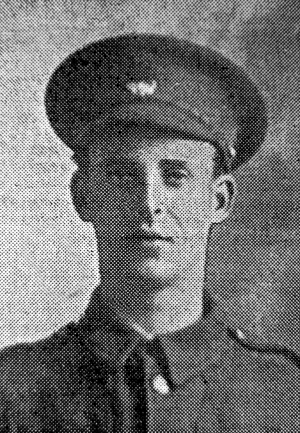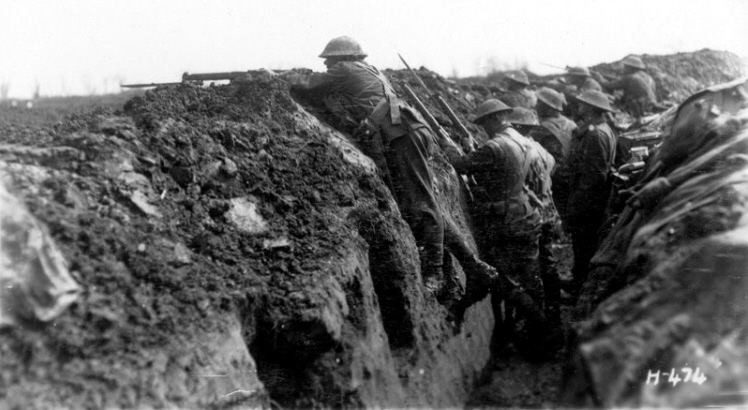
Joseph Kitson was born in the Spring of 1892 in Middlestown, the second child and eldest son of William Kitson and his wife, Amelia (nee Bowers), who married in the Dewsbury area in 1885. The couple had eight children from their marriage, but sadly two of those children died before April 1911. Four of their children were born in Ossett, and it appears that William and Amelia Kitson moved from Middlestown to Ossett in about 1895.
In 1901, the Kitson family, including Joseph, were living at South Parade, Ossett from where William worked as a coal miner at the local Roundwood Colliery. William Kitson died in 1909, aged 47.
By 1911, widow Amelia Kitson had moved to 8, Junction Lane, Ossett and was living in a three-roomed house with six of her children: one daughter and five boys, including Joseph, now aged 18 and working as an underground coal trammer at Old Roundwood Collieries.
Joseph Kitson’s army service record has not survived, but it is known that he enlisted at Wakefield, and embarked for France on 9th July 1915. He was posthumously awarded the British and Victory medals and also the 1914/15 Star to acknowledge that he served overseas before the 31st December 1915.
The KOYLI 1st/4th Battalion was formed in August 1914 at Wakefield as part of the 3rd West Riding Brigade, West Riding Division. They moved on mobilisation to Doncaster and in November 1914 to Gainsborough, then again to to York in February 1915. On the 12th April 1915 they landed at Boulogne and on the 15th May 1915, the formation became 148th Brigade, 49th (West Riding) Division.
On the 7th July 1916, the 1st/4th Battalion, KOYLI were in the Thiepval sector during the Battle of the Somme, taking part in an attack on the village of ‘Ovillers’ (North of Thiepval on the Albert-Bapaume Road). Their “War Diary” for the 7th July 1916 records the following:
“12:30 a.m. – Enemy opened intense bombardment on original British front line. This continued until 2:15 a.m., our artillery replying effectively.”
“02:15 a.m. – The bombardment was turned on to the ‘A’ Line until 02:50 a.m. when it was turned again on to the communications trenches and lines behind.”
“02:50 a.m. – Enemy bombers advanced down the trench towards A.18 and A.16 and across the open to A.17, a furious fight with bombs ensued lasting until 06:30 a.m. Numerous casualties were incurred both from bombs, and enemy snipers who were lying out in the open and who shot down our men as they fired and threw bombs out of the trench. Major H. Moorhouse, D.S.O. in command of the sector was wounded in the arm by a sniper about 04:00 a.m., but remained in command until 05:30 a.m. when forced through loss of blood to go to the Dressing Station, Captain W. M. Williamson, commanding ‘Z’ Company, and 2/Lts. Carter, Massie, Mackay, De Jonquet and Huntington were also wounded. Capt. H.G. Fraser took command and continued the fight until 06:30 a.m. when he ran out of bombs and was forced to retire down the communications trench to the original British Front Line which he held along with the 4th and 5th Y. & L. Regiment already there with the 35 men remaining out of the two companies until 09:30 a.m. when he was ordered to return to the Assembly Trenches in Thiepval Wood.”
“Casualties: Other Ranks, 20 killed and 180 wounded.”

Above: Trench warfare during the Battle of the Somme, July 1916
Private Joseph Kitson, aged 24 years, son of Mrs. Amelia Kitson, of 10, Junction Lane, Ossett, died on the 7th July 1916 and is remembered on Pier and Face 11C and 12A at the Thiepval Memorial, 1 Somme, France. The Thiepval Memorial will be found on the D73, next to the village of Thiepval, off the main Bapaume to Albert road (D929).
On 1 July 1916, supported by a French attack to the south, thirteen divisions of Commonwealth forces launched an offensive on a line from north of Gommecourt to Maricourt. Despite a preliminary bombardment lasting seven days, the German defences were barely touched and the attack met unexpectedly fierce resistance. Losses were catastrophic and with only minimal advances on the southern flank, the initial attack was a failure. In the following weeks, huge resources of manpower and equipment were deployed in an attempt to exploit the modest successes of the first day. However, the German Army resisted tenaciously and repeated attacks and counter attacks meant a major battle for every village, copse and farmhouse gained. At the end of September, Thiepval was finally captured. The village had been an original objective of 1 July. Attacks north and east continued throughout October and into November in increasingly difficult weather conditions. The Battle of the Somme finally ended on 18 November with the onset of winter.
In the spring of 1917, the German forces fell back to their newly prepared defences, the Hindenburg Line, and there were no further significant engagements in the Somme sector until the Germans mounted their major offensive in March 1918.
The Thiepval Memorial, the Memorial to the Missing of the Somme, bears the names of more than 72,000 officers and men of the United Kingdom and South African forces who died in the Somme sector before 20 March 1918 and have no known grave. Over 90% of those commemorated died between July and November 1916. The memorial also serves as an Anglo-French Battle Memorial in recognition of the joint nature of the 1916 offensive and a small cemetery containing equal numbers of Commonwealth and French graves lies at the foot of the memorial.
The memorial, designed by Sir Edwin Lutyens, was built between 1928 and 1932 and unveiled by the Prince of Wales, in the presence of the President of France, on 1 August 1932 (originally scheduled for 16 May but due to the death of French President Doumer the ceremony was postponed until August).
The dead of other Commonwealth countries, who died on the Somme and have no known graves, are commemorated on national memorials elsewhere.
References: